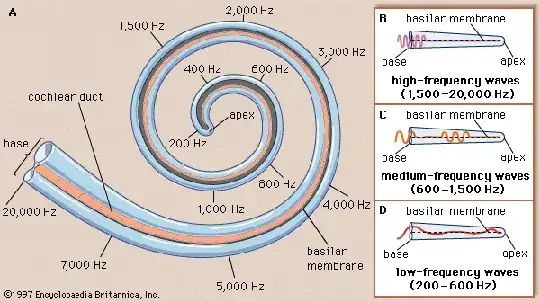The "safe noise exposure limits" I found on the internet only indicates the intensity of the sound in dB, but not the frequency. Does that mean that e.g. a 120dB sound with different frequencies from 20Hz to 20kHz has the same harmful effects on the ear?
2 Answers
Introduction
I don't think this is so simple as to be answered with a "yes" or "no". The hearing system is rather complex on its own and comprises of both mechanical and "electrical" (chemical/neurological) sub-systems.
Damage severity
Both kind of systems (mechanical and "electrical") can be damaged by excessive acoustic energy. In another answer is stated that the first to be damaged are the hair cells. This may be (partially) true but the middle ear (the tympani and the ossicles) can also be damaged by sudden (impulsive) high pressure waves.
Although hair cells tend to be more sensitive, there's more of them and losing some of them is not necessarily as catastrophic as getting your tympani ruptured$^{*}$. Arguably, both systems have the ability to recover, but this is only to a certain extent.
Notably, nowadays (hopefully this will change in the future) medical treatment is easier and more successful at the outer and middle parts of the ear. This makes damages to the inner ear less "reversible" (or fixable if you'd like it more) and thus more serious in a sense.
Kinds of damage
As already mentioned, impulsive bursts of excessive pressure can very well damage many parts of the ear. Consulting the Fletcher-Munson curves (Equal Loudness Contours) you'll see for yourself that the ear is indeed more sensitive in some frequencies compared to others. This has serious consequences on the mechanical parts of the ear and most prominently, the middle ear.
As an example, let's note that in the region of $3 ~ kHz$ to $4 ~ kHz$ the ear is very sensitive due to the length of the ear canal. For a given, constant intensity, in this frequency range the energy that will go into the hearing system will be higher than any other frequency range. Thus, in this frequency range it is easier to witness hearing impairments (although there's not much we can do in our everyday life).
Additionally, one could consider the effect that some frequencies have on other frequencies in the hearing system. To be more specific, one of the reasons (and to my knowledge the most prominent one) that people progressively lose their sensitivity in the higher frequencies is because they are "located" closer to the oval window (which is the intersection between the middle and inner ear).
Taking a look at the following picture you'll see that each part of the cochlea is "mapped" to a certain frequency range. The high frequencies are closer to the oval window where the travelling waves that excite the hair cells come into the cochlea. This means that even the for a low frequency excitation, the wave has to first pass through the high frequency region. This results in the hair cells being worn out a lot faster.
Summary
As it seems, the characteristics of the excitation signal plays a role on which parts of the ear will be affected the most (please note that in all cases most - if not all - parts of the ear are affected to some degree). Impulsive sounds tend to have more severe effect on the middle ear while sounds with greater duration seem to worn out the inner ear hair cells. Since the noise around us contains both types of signals they are should both be taken into account when making risk assessments and try to devise safety plans.
In the light of that, keep in mind that the easiest way to get some metrics in order to reach conclusions on matters that affect large populations and/or long periods of time is to use energy metrics. This is what WHO and NIOSH suggest and this is what the Equivalent Levels ($L_{eq}$) correspond to.
$^{*}$ The function of hair cells is to perform some kind of frequency analysis. Thus, they are arranged in such a way to resemble a filterbank (plus they also perform the mechanical-to-electrical conversion through some bio-chemical process). It is worth noting that, according to Wikipedia (apologies, I can't search for another, more reliable source now) there's about 12000 outer and 3500 inner hair cells.
Since the excitation of the hair cells is not completely localised, for a monochromatic excitation signal (even more for broadband) many of the hair cells in the vicinity of the centrally excited ones will be also affected, so losing some does not render you completely "deaf" to those frequencies, but it definitely lowers your sensitivity to them (or increases your hearing threshold).
- 1,824
As the intensity of the sound increases from safe levels into dangerous levels, the first things to be damaged in your ear will be the various hair cells that respond to the various frequency components of the sound.
You could consider the damage done by sounds with different frequency components to be "the same" if the same amount of damage was done, or you could consider the damage to be "different" because different hair cells were affected.
- 17,057
